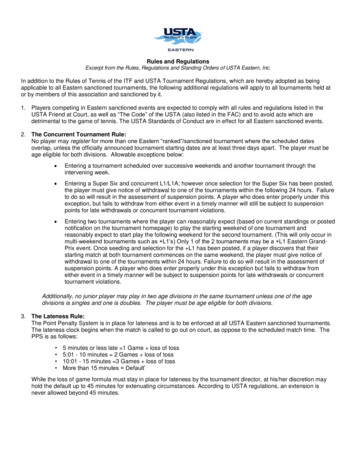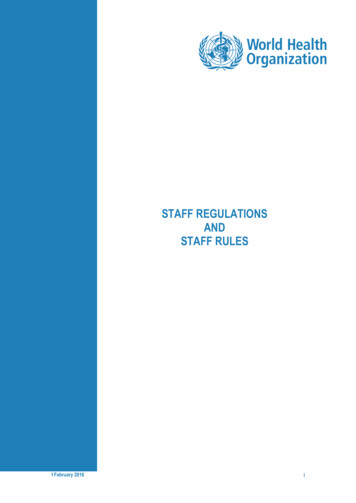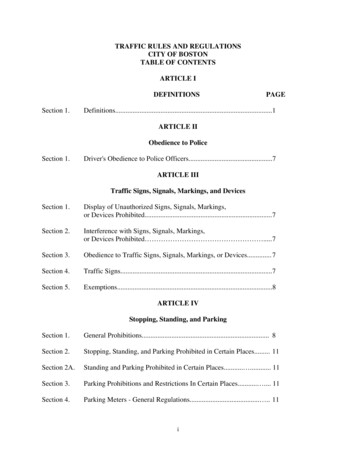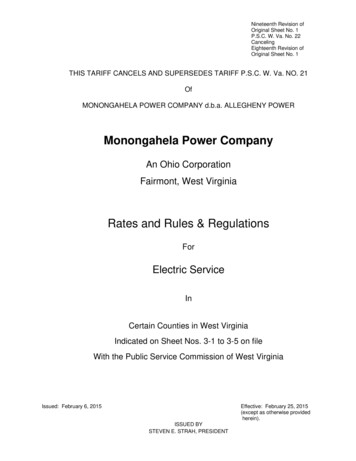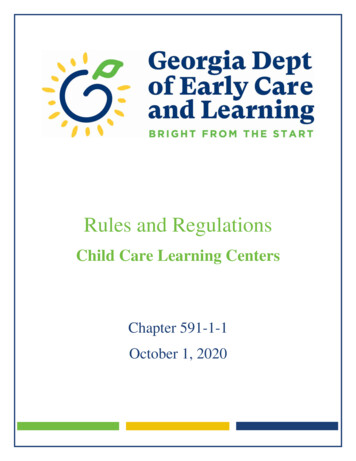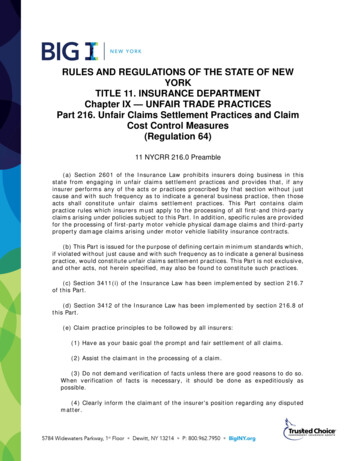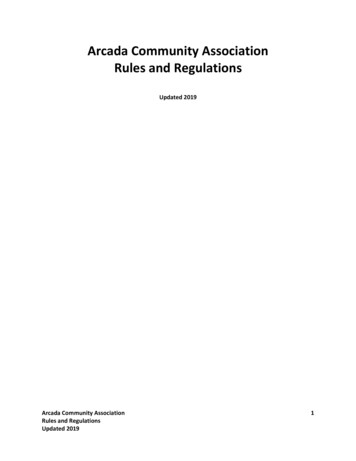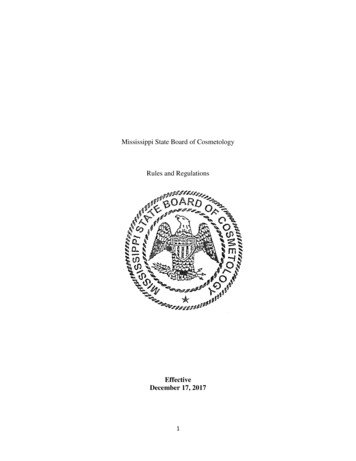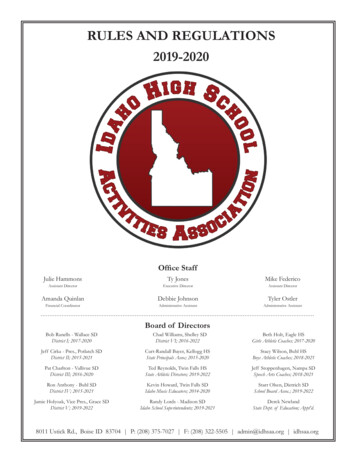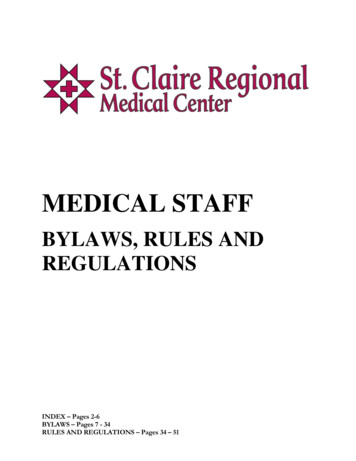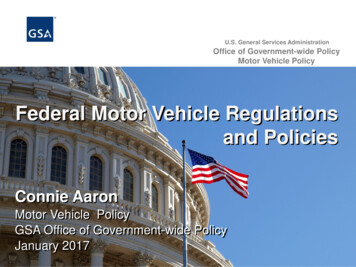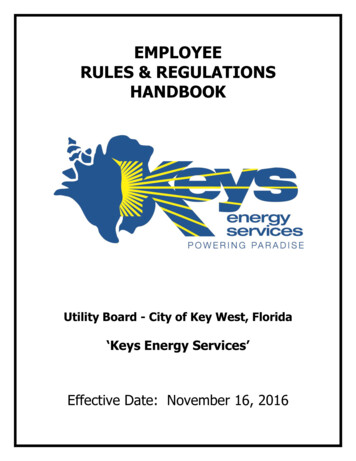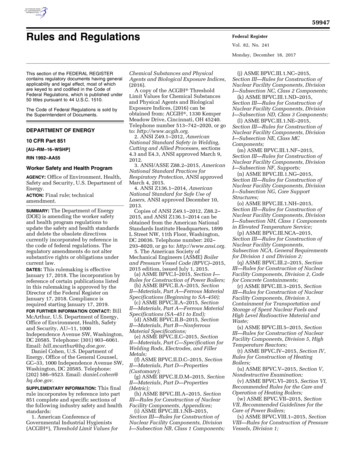
Transcription
59947Rules and RegulationsFederal RegisterVol. 82, No. 241Monday, December 18, 2017This section of the FEDERAL REGISTERcontains regulatory documents having generalapplicability and legal effect, most of whichare keyed to and codified in the Code ofFederal Regulations, which is published under50 titles pursuant to 44 U.S.C. 1510.The Code of Federal Regulations is sold bythe Superintendent of Documents.DEPARTMENT OF ENERGY10 CFR Part 851[AU–RM–16–WSHP]RIN 1992–AA55Worker Safety and Health ProgramOffice of Environment, Health,Safety and Security, U.S. Department ofEnergy.ACTION: Final rule; technicalamendment.AGENCY:The Department of Energy(DOE) is amending the worker safetyand health program regulations toupdate the safety and health standardsand delete the obsolete directivescurrently incorporated by reference inthe code of federal regulations. Theregulatory amendments do not altersubstantive rights or obligations undercurrent law.DATES: This rulemaking is effectiveJanuary 17, 2018. The incorporation byreference of certain publications listedin this rulemaking is approved by theDirector of the Federal Register onJanuary 17, 2018. Compliance isrequired starting January 17, 2019.FOR FURTHER INFORMATION CONTACT: BillMcArthur, U.S. Department of Energy,Office of Environment, Health, Safetyand Security, AU–11, 1000Independence Avenue SW, Washington,DC 20585. Telephone: (301) 903–6061.Email: bill.mcarthur@hq.doe.gov.Daniel Cohen, U.S. Department ofEnergy, Office of the General Counsel,GC–33, 1000 Independence Avenue SW,Washington, DC 20585. Telephone:(202) 586–9523. Email: daniel.cohen@hq.doe.gov.SUPPLEMENTARY INFORMATION: This finalrule incorporates by reference into part851 complete and specific sections ofthe following industry safety and healthstandards:1. American Conference ofGovernmental Industrial Hygienists(ACGIH ), Threshold Limit Values forPmangrum on DSK3GDR082PROD with RULESSUMMARY:VerDate Sep 11 201415:19 Dec 15, 2017Jkt 244001Chemical Substances and PhysicalAgents and Biological Exposure Indices,(2016).A copy of the ACGIH ThresholdLimit Values for Chemical Substancesand Physical Agents and BiologicalExposure Indices, (2016) can beobtained from: ACGIH , 1330 KemperMeadow Drive, Cincinnati, OH 45240.Telephone number 513–742–2020, or goto: http://www.acgih.org.2. ANSI Z49.1–2012, AmericanNational Standard Safety in Welding,Cutting and Allied Processes, sections4.3 and E4.3, ANSI approved March 9,2012.3. ANSI/ASSE Z88.2–2015, AmericanNational Standard Practices forRespiratory Protection, ANSI approvedMarch 4, 2015.4. ANSI Z136.1–2014, AmericanNational Standard for Safe Use ofLasers, ANSI approved December 10,2013.Copies of ANSI Z49.1–2012, Z88.2–2015, and ANSI Z136.1–2014 can beobtained from the American NationalStandards Institute Headquarters, 1899L Street NW, 11th Floor, Washington,DC 20036. Telephone number: 202–293–8020, or go to: http://www.ansi.org.5. The American Society ofMechanical Engineers (ASME) Boilerand Pressure Vessel Code (BPVC)–2015,2015 edition, issued July 1, 2015.(a) ASME BPVC.I–2015, Section I—Rules for Construction of Power Boilers;(b) ASME BPVC.II.A–2015, SectionII—Materials, Part A—Ferrous MaterialSpecifications (Beginning to SA–450);(c) ASME BPVC.II.A–2015, SectionII—Materials, Part A—Ferrous MaterialSpecifications (SA–451 to End);(d) ASME BPVC.II.B–2015, SectionII—Materials, Part B—NonferrousMaterial Specifications;(e) ASME BPVC.II.C–2015, SectionII—Materials, Part C—Specification forWelding Rods, Electrodes, and FillerMetals;(f) ASME BPVC.II.D.C–2015, SectionII—Materials, Part D—Properties(Customary);(g) ASME BPVC.II.D.M–2015, SectionII—Materials, Part D—Properties(Metric);(h) ASME BPVC.III.A–2015, SectionIII—Rules for Construction of NuclearFacility Components, Appendices;(i) ASME BPVC.III.1.NB–2015,Section III—Rules for Construction ofNuclear Facility Components, DivisionI—Subsection NB, Class 1 Components;PO 00000Frm 00001Fmt 4700Sfmt 4700(j) ASME BPVC.III.1.NC–2015,Section III—Rules for Construction ofNuclear Facility Components, DivisionI—Subsection NC, Class 2 Components;(k) ASME BPVC.III.1.ND–2015,Section III—Rules for Construction ofNuclear Facility Components, DivisionI—Subsection ND, Class 3 Components;(l) ASME BPVC.III.1.NE–2015,Section III—Rules for Construction ofNuclear Facility Components, DivisionI—Subsection NE, Class MCComponents;(m) ASME BPVC.III.1.NF–2015,Section III—Rules for Construction ofNuclear Facility Components, DivisionI—Subsection NF, Supports;(n) ASME BPVC.III.1.NG–2015,Section III—Rules for Construction ofNuclear Facility Components, DivisionI—Subsection NG, Core SupportStructures;(o) ASME BPVC.III.1.NH–2015,Section III—Rules for Construction ofNuclear Facility Components, DivisionI—Subsection NH, Class 1 Componentsin Elevated Temperature Service;(p) ASME BPVC.III.NCA–2015,Section III—Rules for Construction ofNuclear Facility Components,Subsection NCA, General Requirementsfor Division 1 and Division 2;(q) ASME BPVC.III.2–2015, SectionIII—Rules for Construction of NuclearFacility Components, Division 2, Codefor Concrete Containments;(r) ASME BPVC.III.3–2015, SectionIII—Rules for Construction of NuclearFacility Components, Division 3,Containment for Transportation andStorage of Spent Nuclear Fuels andHigh Level Radioactive Material andWaste;(s) ASME BPVC.III.5–2015, SectionIII—Rules for Construction of NuclearFacility Components, Division 5, HighTemperature Reactors;(t) ASME BPVC.IV–2015, Section IV,Rules for Construction of HeatingBoilers;(u) ASME BPVC.V–2015, Section V,Nondestructive Examination;(v) ASME BPVC.VI–2015, Section VI,Recommended Rules for the Care andOperation of Heating Boilers;(w) ASME BPVC.VII–2015, SectionVII, Recommended Guidelines for theCare of Power Boilers;(x) ASME BPVC.VIII.1–2015, SectionVIII—Rules for Construction of PressureVessels, Division 1;E:\FR\FM\18DER1.SGM18DER1
Pmangrum on DSK3GDR082PROD with RULES59948Federal Register / Vol. 82, No. 241 / Monday, December 18, 2017 / Rules and Regulations(y) ASME BPVC.VIII.2–2015, SectionVIII—Rules for Construction of PressureVessels, Division 2, Alternative Rules;(z) ASME BPVC.VIII.3–2015, SectionVIII—Rules for Construction of PressureVessels, Division 3, Alternative Rules forConstruction of High Pressure Vessels;(aa) ASME BPVC.IX–2015, SectionIX—Welding, Brazing and FusingQualifications, Qualification Standardfor Welding, Brazing, and FusingProcedures; Welders; Brazers; andWelding, Brazing, and Fusing Operators;(bb) ASME BPVC.X–2015, Section X,Fiber-Reinforced Plastic PressureVessels;(cc) ASME BPVC.XI–2015, Section XI,Rules for Inservice Inspection of NuclearPower Plant Components;(dd) ASME BPVC.XII–2015, SectionXII, Rules for Construction andContinued Service of Transport Tanks;(ee) ASME BPVC.CC.BPV–2015, CodeCases, Boilers and Pressure Vessels; and(ff) ASME BPVC.CC.NC–2015, CodeCases, Nuclear Components.6. ASME B31.1–2016, Power Piping,ASME Code for Pressure Piping, B31,issued June 30, 2016.7. ASME B31.3–2014, Process Piping,ASME Code for Pressure Piping, B31,issued February 27, 2015.8. ASME B31.4–2016, PipelineTransportation Systems for Liquids andSlurries, ASME Code for PressurePiping, B31, issued March 31, 2016.9. ASME B31.5–2016, RefrigerationPiping and Heat Transfer Components,ASME Code for Pressure Piping, B31,issued June 29, 2016.10. ASME B31.8–2016, GasTransmission and Distribution PipingSystems, ASME Code for PressurePiping, B31, issued September 30, 2014.11. ASME B31.8S–2014, ManagingSystem Integrity of Gas Pipelines, ASMECode for Pressure Piping, B31,Supplement to ASME B31.8, issuedSeptember 30, 2014.12. ASME B31.9–2014, BuildingServices Piping, ASME Code forPressure Piping, B31, issued April 28,2014.13. ASME B31G–2012, Manual forDetermining the Remaining Strength ofCorroded Pipelines, Supplement toASME B31 Code for Pressure Piping,issued October 24, 2012.Copies of ASME BPVC–2015, BPVC.I–2015, BPVC.II.A–2015, BPVC.II.A–2015,BPVC.II.B–2015, BPVC.II.C–2015,BPVC.II.D.C–2015, BPVC.II.D.M–2015,BPVC.III.A–2015, BPVC.III.1.NB–2015,BPVC.III.1.NC–2015, BPVC.III.1.ND–2015, BPVC.III.1.NE–2015,BPVC.III.1.NF–2015, BPVC.III.1.NG–2015, BPVC.III.1.NH–2015,BPVC.III.NCA–2015, BPVC.III.2–2015,BPVC.III.3–2015, BPVC.III.5–2015,VerDate Sep 11 201415:19 Dec 15, 2017Jkt 244001BPVC.IV–2015, BPVC.V–2015,BPVC.VI–2015, BPVC.VII–2015,BPVC.VIII.1–2015, BPVC.VIII.2–2015,BPVC.VIII.3–2015, BPVC.IX–2015,BPVC.X–2015, BPVC.XI–2015,BPVC.XII–2015, BPVC.CC.BPV–2015,BPVC.CC.NC–2015, B31.1–2016, B31.3–2016, B31.4–2016, B31.5–2016, B31.8–2016, B31.8S–2014, B31.9–2014 andB31G–2012 can be obtained from:American Society of MechanicalEngineers (ASME), P.O. Box 2300Fairfield, NJ 07007. Telephone: 800–843–2763, or got to: http://www.asme.org.14. National Fire ProtectionAssociation (NFPA) 70, NationalElectric Code, (2017), issued August 4,2016.15. NFPA 70E, Standard for ElectricalSafety in the Workplace, (2015 edition),July 14, 2014.Copies of NFPA 70 (2017) and 70E(2015) can be obtained from: NationalFire Protection Association, OneBatterymarch Park, Quincy, MA 02169.Telephone: 617 770–3000, or go to:http://www.nfpa.org.For a further discussion of thesestandards, see section II.(AEC) to protect health and promotesafety during the performance ofactivities under the AEA. See Sec.31a.(5) of AEA, 42 U.S.C. 2051(a)(5);Sec. 161b. of AEA, 42 U.S.C 2201(b);Sec. 161i.(3) of AEA, 42 U.S.C.2201(i)(3); and Sec. 161p. of AEA, 42U.S.C. 2201(p). The ERA abolished theAEC and replaced it with the NuclearRegulatory Commission (NRC), whichbecame responsible for the licensing ofcommercial nuclear activities, and theEnergy Research and DevelopmentAdministration (ERDA), which becameresponsible for the other functions ofthe AEC under the AEA, as well asseveral nonnuclear functions. The ERAauthorized ERDA to use the regulatoryauthority under the AEA to carry out itsnuclear and nonnuclear function,including those functions that mightbecome vested in ERDA in the future.See Sec. 105(a) of ERA, 42 U.S.C.5815(a); and Sec. 107 of ERA, 42 U.S.C.5817. The DOEOA transferred thefunctions and authorities of ERDA toDOE. See Sec. 301(a) of DOEOA, 42U.S.C. 7151(a); Sec. 641 of DOEOA, 42U.S.C. 7251; and Sec. 644 of DOEOA, 42U.S.C. 7254.Table of ContentsB. BackgroundOn February 9, 2006 (71 FR 6858),when DOE promulgated 10 CFR part851, Worker Safety and Health Program,it adopted several industry standards toestablish the baseline technical safetyand health requirements for DOEworkplace operations. These standardswere already required by DOE Order440.1A, Worker Protection Managementfor DOE Federal and ContractorEmployees, which established acomprehensive worker protectionprogram that provided the basicframework necessary for contractors toensure the safety and health of theirworkforce.In this final rule, DOE replaces theexisting references to industry safetyand health standards with directreferences to the latest versions of theappropriate standards. Directlyreferencing the latest industry standardswill allow DOE to adopt current bestpractices and procedures in safety andhealth.I. Authority and BackgroundA. AuthorityB. BackgroundII. Description of Materials Incorporated byReferenceIII. Procedural RequirementsA. Review Under Executive Order 12866B. Review Under the Regulatory FlexibilityActC. Review Under the Paperwork ReductionActD. Review Under the NationalEnvironmental Policy ActE. Review Under Executive Order 12988F. Review Under Executive Order 13132G. Review Under the Unfunded MandatesReform Act of 1995H. Review Under Executive Order 13211I. Review Under the Treasury and GeneralGovernment Appropriations Act, 1999J. Review Under the Treasury and GeneralGovernment Appropriations Act, 2001K. Administrative Procedures ActL. Congressional NotificationIV. Approval of the Office of the SecretaryI. Authority and BackgroundA. AuthorityDOE has broad authority to regulateworker safety and health with respect toits nuclear and nonnuclear functionspursuant to the Atomic Energy Act of1954 (AEA), 42 U.S.C. 2011 et seq.; theEnergy Reorganization Act of 1974(ERA), 42 U.S.C. 5801–5911; and theDepartment of Energy Organization Act(DOEOA), 42 U.S.C. 7101–7352.Specifically, the AEA authorized anddirected the Atomic Energy CommissionPO 00000Frm 00002Fmt 4700Sfmt 4700II. Description of MaterialsIncorporated by ReferenceDOE incorporates by reference thethreshold limit values (TLVs ) forchemical substances and physicalagents and biological exposure indices(BEIs ) published by the AmericanConference of Governmental IndustrialHygienists (ACGIH ) titled ‘‘ThresholdLimit Values for Chemical Substancesand Physical Agents and BiologicalE:\FR\FM\18DER1.SGM18DER1
Pmangrum on DSK3GDR082PROD with RULESFederal Register / Vol. 82, No. 241 / Monday, December 18, 2017 / Rules and RegulationsExposure Indices,’’ (2016). The TLVs and BEIs are industry accepted valuesthat are intended for use by industrialhygienists in making decisionsregarding safe levels of exposure tovarious chemical and physical agentsfound in the workplace. Each yearACGIH publishes its TLVs and BEIs .Copies of the ACGIH TLVs and BEIs are readily available on ACGIH ’swebsite at: http://www.acgih.org.DOE incorporates by reference thefollowing industry standards publishedby the American National StandardsInstitute (ANSI):ANSI Z49.1–2012, Safety in Welding,Cutting and Allied Processes, sections4.3 and E4.3. ANSI Z49.1–2012 providesguidance for the protection of personsfrom injury and illness and theprotection of property (includingequipment) from damage by fire andexplosions arising from welding,cutting, and allied processes. Copies ofANSI Z49.1–2012 is readily available onANSI’s website at: http://www.ansi.org.ANSI Z88.2–2015, American NationalStandard Practices for RespiratoryProtection. ANSI Z88.2–2015 is anindustry accepted standard that setsforth minimally accepted practices foroccupational respirator use; providesinformation and guidance on the properselection, use and maintenance ofrespirators and contains requirementsfor establishing, implementing andevaluating respirator programs. Copiesof ANSI Z88.2–2015 is readily availableon ANSI’s website at: http://www.ansi.org.ANSI Z136.1–2014, Safe Use ofLasers. ANSI Z136.1–2014 is anindustry accepted standard thatprovides guidance for the safe use oflasers and laser systems by definingcontrol measures for each of seven laserhazard classifications. Copies of ANSIZ136.1–2014 is readily available onANSI’s website at: http://www.ansi.org.DOE also incorporates by referencethe following specific industrystandards for pressure piping codespublished by the American Society forMechanical Engineers (ASME):ASME Boiler and Pressure VesselCode (BPVC)–2015. ASME’s BPVCstandard establishes rules of safetyrelating only to pressure integrity—governing the design, fabrication, andinspection of boilers and pressurevessels, and nuclear power plantcomponents during construction. Theobjective of the rules is to provide amargin for deterioration in service. TheCode Cases clarify the existingrequirements or provide, when the needis urgent, rules for materials orconstructions not covered by existingBPVC rules.VerDate Sep 11 201415:19 Dec 15, 2017Jkt 244001ASME BPVC.I–2015, Section I—Rulesfor Construction of Power Boilers. Thissection provides requirements for allmethods of construction of power,electric, and miniature boilers; hightemperature water boilers, heat recoverysteam generators, and certain firedpressure vessels to be used in stationaryservice; and power boilers used inlocomotive, portable, and tractionservice. Rules pertaining to use of the V,A, M, PP, S and E ASME ProductCertification Marks are also included.The rules are applicable to boilers inwhich steam or other vapor is generatedat a pressures exceeding 15 psig, andhigh temperature water boilers intendedfor operation at pressures exceeding 160psig and/or temperatures exceeding 250degree F. Super heaters, economizers,and other pressure parts connecteddirectly to the boiler withoutintervening valves are considered aspart of the scope of Section I.ASME BPVC.II.A–2015, Section II—Materials, Part A—Ferrous MaterialSpecifications (Beginning to SA–450).This section is a ‘‘Service Section’’ tothe other BPVC Sections, providingmaterial specifications for ferrousmaterials adequate for safety in the fieldof pressure equipment. Thesespecifications contain requirements forchemical and mechanical properties,heat treatment, manufacture, heat andproduct analyses, and methods oftesting. They are designated by SAnumbers and are identical with orsimilar to those of specificationspublished by American Society forTesting and Materials (ASTM) and otherrecognized national or internationalorganizations.ASME BPVC.II.A–2015, Section II—Materials, Part A—Ferrous MaterialSpecifications (SA–451 to End). Thissection is a ‘‘Service Section’’ to theother BPVC Sections, providing materialspecifications for ferrous materialsadequate for safety in the field ofpressure equipment. Thesespecifications contain requirements forchemical and mechanical properties,heat treatment, manufacture, heat andproduct analyses, and methods oftesting. They are designated by SAnumbers and are identical with orsimilar to those of specificationspublished by ASTM and otherrecognized national or internationalorganizations.ASME BPVC.II.B–2015, Section II—Materials, Part B—Nonferrous MaterialSpecifications. This section is a‘‘Service Section’’ to the other BPVCSections, providing materialspecifications for ferrous materialsadequate for safety in the field ofpressure equipment. ThesePO 00000Frm 00003Fmt 4700Sfmt 470059949specifications contain requirements forchemical and mechanical properties,heat treatment, manufacture, heat andproduct analyses, and methods oftesting. They are designated by SBnumbers and are identical with orsimilar to those of specificationspublished by ASTM and otherrecognized national or internationalorganizations.ASME BPVC.II.C–2015, Section II—Materials, Part C—Specification forWelding Rods, Electrodes, and FillerMetals. This section is a ‘‘ServiceSection’’ to the other BPVC Sectionsproviding material specifications for themanufacture, acceptability, chemicalcomposition, mechanical usability,surfacing, testing requirements andprocedures, operating characteristics,and intended uses for welding rods,electrodes and filler metals. Thesespecifications are designated by SFAnumbers and are derived from AWSspecifications.ASME BPVC.II.D.C–2015, Section II—Materials, Part D—Properties(Customary). This section is a ‘‘ServiceSection’’ for reference by the BPVCconstruction Sections providing tablesof material properties includingallowable, design, tensile and yieldstress values, physical properties andexternal pressure charts and tables. PartD facilitates ready identification ofmaterials to specific Sections of theBPVC. Part D contains appendiceswhich contain criteria for establishingallowable stress, the bases forestablishing external pressure charts,and information required for approval ofnew materials.ASME BPVC.II.D.M–2015, SectionII—Materials, Part —Properties (Metric).This section is a ‘‘Service Section’’ forreference by the BPVC constructionSections providing tables of materialproperties including allowable, design,tensile and yield stress values, physicalproperties and external pressure chartsand tables. Part D facilitates readyidentification of materials to specificSections of the Boiler and PressureVessel Code. Part D contains appendiceswhich contain criteria for establishingallowable stress, the bases forestablishing external pressure charts,and information required for approval ofnew materials.ASME BPVC.III.A–2015, Section III—Rules for Construction of NuclearFacility Components, Appendices. Thissection contains appendices, bothmandatory and nonmandatory forSection III, Division 1 (Subsection NCAthrough NG) and Division 2, includinga listing of design and design analysismethods and information, and DataReport Forms. These appendices areE:\FR\FM\18DER1.SGM18DER1
Pmangrum on DSK3GDR082PROD with RULES59950Federal Register / Vol. 82, No. 241 / Monday, December 18, 2017 / Rules and Regulationsreferenced by and are an integral part ofSubsection NCA through NG andDivision 2.ASME BPVC.III.1.NB–2015, SectionIII—Rules for Construction of NuclearFacility Components, Division I—Subsection NB, Class 1 Components.This subsection contains requirementsfor the material, design, fabrication,examination, testing and overpressureprotection of items which are intendedto conform to the requirements for Class1 construction. The rules of SubsectionNB cover the requirements for assuringthe structural integrity of items.ASME BPVC.III.1.NC–2015, SectionIII—Rules for Construction of NuclearFacility Components, Division I—Subsection NC, Class 2 Component.This subsection contains requirementsfor the material, design, fabrication,examination, testing and overpressureprotection of items which are intendedto conform to the requirements for Class2 construction. The rules of SubsectionNC cover the requirements for assuringthe structural integrity of items.ASME BPVC.III.1.ND–2015, SectionIII—Rules for Construction of NuclearFacility Components, Division I—Subsection ND, Class 3 Components.This subsection contains requirementsfor the material, design, fabrication,examination, testing and overpressureprotection of items which are intendedto conform to the requirements for Class3 construction. The rules of SubsectionND cover the requirements for assuringthe structural integrity of items.ASME BPVC.III.1.NE–2015, SectionIII—Rules for Construction of NuclearFacility Components, Division I—Subsection NE, Class MC Components.This subsection contains requirementsfor the material, design, fabrication,examination, testing and overpressureprotection of items which are intendedto conform to the requirements for ClassMC construction. The rules ofSubsection NE cover the requirementsfor assuring the structural integrity ofitems.ASME BPVC.III.1.NF–2015, SectionIII—Rules for Construction of NuclearFacility Components, Division I—Subsection NF, Supports. Thissubsection contains requirements for thematerial, design, fabrication, andexamination of supports which areintended to conform to the requirementsfor Classes 1, 2, 3, and MC construction.Nuclear power plant supports for whichrules are specified in this Subsection arethose metal supports which aredesigned to transmit loads from thepressure retaining barrier of thecomponent or piping to the loadcarrying building structure. In somecases there may be intervening elementsVerDate Sep 11 201415:19 Dec 15, 2017Jkt 244001in the component support load pathwhich are not constructed to the rulesof this Section, such as diesel engines,electric motors, valve operators, coolers,and access structures.ASME BPVC.III.1.NG–2015, SectionIII—Rules for Construction of NuclearFacility Components, Division I—Subsection NG, Core SupportStructures. This subsection containsrequirements for the material, design,fabrication, and examination required inthe manufacture and installation of coresupport structures. Core supportstructures are those structures or partsof structures which are designed toprovide direct support or restraint of thecore (fuel & blanket assemblies) withinthe reactor pressure vessel.ASME BPVC.III.1.NH–2015, SectionIII—Rules for Construction of NuclearFacility Components, Division I—Subsection NH, Class 1 Components inElevated Temperature Service. Thissubsection contains requirements for thematerial, design, fabrication, andexamination required in themanufacture and installation of coresupport structures. Core supportstructures are those structures or partsof structures which are designed toprovide direct support or restraint of thecore (fuel & blanket assemblies) withinthe reactor pressure vessel.ASME BPVC.III.NCA–2015, SectionIII—Rules for Construction of NuclearFacility Components, Subsection NCA,General Requirements for Division 1and Division 2. This subsection containsgeneral requirements for manufacturers,fabricators, installers, designers,material manufacturers, materialsuppliers, and owners of nuclear powerplants. This Subsection which isreferenced by and is an integral part ofDivision 1, Subsections NB through NG,and Division 2 of Section III, coversquality assurance requirements, ASMEProduct Certification Marks, andauthorized inspection for Class 1, 2, 3,MC, CS, and CC construction. Selectivereference of ASME Standard NQA–1,Quality Assurance ProgramRequirements for Nuclear Facilities, ismade in this Subsection.ASME BPVC.III.2–2015, Section III—Rules for Construction of NuclearFacility Components, Division 2, Codefor Concrete Containments. Thisdivision contains requirements for thematerial, design, construction,fabrication, testing, examination, andoverpressure protection of concretecontainment structures, pre-stressed orreinforced. These requirements areapplicable only to those componentsthat are designed to provide a pressureretaining or containing barrier. They arenot applicable to other supportPO 00000Frm 00004Fmt 4700Sfmt 4700structures, except as they directly affectthe components of the systems. ThisSection contains appendices, bothmandatory and nonmandatory, forDivision 2 construction.ASME BPVC.III.3–2015, Section III—Rules for Construction of NuclearFacility Components, Division 3,Containment for Transportation andStorage of Spent Nuclear Fuels andHigh Level Radioactive Material andWaste. This division containsrequirements for the design andconstruction of the containment systemof a nuclear spent fuel or high levelradioactive waste transport packaging.ASME BPVC.III.5–2015, Section III—Rules for Construction of NuclearFacility Components, Division 5, HighTemperature Reactors. This divisionprovides construction rules for hightemperature reactors, including bothhigh-temperature, gas-cooled reactors(HTGRs) and liquid-metal reactors(LMRs). These rules are for componentsexceeding the temperature in Division 1and are meant for componentsexperiencing temperatures that areequal, to or higher than, 700 F (370 C)for ferritic materials or 800 F (425 C)for austenitic stainless steels or highnickel alloys. Division 5 also containsthe new rules pertaining to graphite corecomponents. These new rules includegeneral requirements, plus design andconstruction rules, for graphite.Irradiation effects on graphite areaddressed, as are the features ofprobabilistic design reflected in thedetermination of graphite materialstrength properties.ASME BPVC.IV–2015, Section IV,Rules for Construction of HeatingBoilers. This section providesrequirements for design, fabrication,installation and inspection of steamheating, hot water heating, hot watersupply boilers, and potable waterheaters intended for low pressureservice that are directly fired by oil, gas,electricity, coal or other solid or liquidfuels. It contains appendices whichcover approval of new material,methods of checking safety valve andsafety relief valve capacity, examples ofmethods of checking safety valve andsafety relief valve capacity, examples ofmethods of calculation andcomputation, definitions relating toboiler design and welding, and qualitycontrol systems. Rules pertaining to useof the H, HV, and HLW ASME ProductCertification Marks are also included.ASME BPVC.V–2015, Section V,Nondestructive Examination. Thissection contains requirements andmethods for nondestructive examinationwhich are referenced and required byother BPVC Sections. It also includesE:\FR\FM\18DER1.SGM18DER1
Pmangrum on DSK3GDR082PROD with RULESFederal Register / Vol. 82, No. 241 / Monday, December 18, 2017 / Rules and Regulationsmanufacturer’s examinationresponsibilities, duties of authorizedinspectors and requirements forqualification of personnel, inspectionand examination. Examination methodsare intended to detect surface andinternal discontinuities in materials,welds, and fabricated parts andcomponents. A glossary of related termsis included.ASME BPVC.VI–2015, Section VI,Recommended Rules for the Care andOperation of Heating Boilers. Thissection covers general descriptions,terminology and operation guidelinesapplicable to steel and cast iron boilerslimited to the operating ranges ofSection IV Heating Boilers. It includesguidelines for associated controls andautomatic fuel burning equipment.Illustrations show typical examples ofavailable equipment. Also included is aglossary of terms commonly associatedwith boilers, controls, and fuel burningequipment.ASME BPVC.VII–2015, Section VII,Recommended Guidelines for the Careof Power Boilers. The purpose of theserecommend guidelines is to promotesafety in the use of power boilers. Theterm ‘‘power boiler’’ in this sectionincludes stationary, portable, andtraction type boilers, but does notinclude locomotive and hightemperature water boilers, nuclearpower plant boilers, heating boilers,pressure vessels, or marine boilers. Thissection provides such guidelines toassist those directly responsible foroperating, maintaining, and inspectingpower boilers. Emphasis has beenplaced on industrial type boilersbecause of their extensive use.Guidelines are also provided foroperation of auxiliary equipment andappliances that affect the safe andreliable operation of power boilers.ASME BPVC.VIII.1–2015, SectionVIII—Rules for Construction of PressureVessels, Division 1. This divisionprovides requirements applicable to thedesign, fabrication, inspection, testing,and certification of pressure vesselsoperating at either internal or externalpressures exceeding 15 psig. Suchpressure vessels may be fired or unfired.Specific requirements apply to severalclasses of material used in pressurevessel construction, and also tofabrication methods such as welding,forging and brazing. It containsmandatory and nonmandatoryappendices detailing supplementarydesign criteria, nondestructiveexamination and inspection acceptancestandards. Rules pertaining to the use ofthe U, UM and UV ASME ProductCertification Marks are also included.Ve
The American Society of Mechanical Engineers (ASME) Boiler and Pressure Vessel Code (BPVC)–2015, 2015 edition, issued July 1, 2015. (a) ASME BPVC.I–2015, Section I— Rules for Construction of Power Boilers; (b) ASME BPVC
